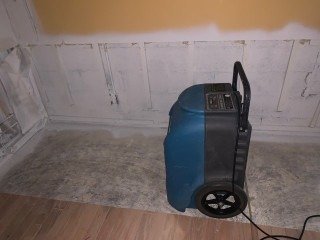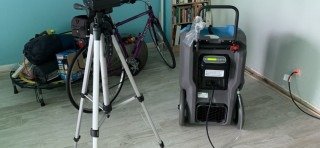Does A Dehumidifier Kill Mold?
Expert insight by: Brad Fishbein, Licensed Mold Assessor
Updated February 21, 2023
It's no secret that the humidity level in the home is a key factor in having a mold problem. But can a dehumidifier kill mold spores?
Well...
Sort of, however, there is much more that goes into it. A dehumidifier is certainly a key ingredient in mold remediation. But if you are hoping just to set up a dehumidifier in your home and magically expect it to remove mold, you will be severely disappointed.
Taking it one step further a dehumidifier won't improve indoor air quality in the home either, but more on that later.
In this article, we will tell you everything you need know about using a dehumidifier for mold.
How Is A Dehumidifier Help With Mold
I'm assuming if you are reading this you know what a dehumidifier does, but if not, A dehumidifier is an electrical appliance that removes moisture from the air.
Dehumidifiers can either be stand-alone units or sometimes be built into a central air conditioning unit.

A dehumidifier works by drawing in humid air through vents located at the top of the unit, which passes over cold evaporator coils inside the machine. As this warm moist air comes into contact with these cold coils, condensation forms on them as water droplets collect together before being removed via drainage pipes (such as in a shower or a sink) or collected in tanks for later disposal outside of your home or building.
A dehumidifier serves one purpose:
To reduce indoor humidity levels in homes and other buildings.
That being said there are benefits in removing excess humidity and controlling moisture levels in a home.
The biggest benefit is to prevent mold growth.
You see, mold needs humidity above 60% to really be able to grow and thrive. There are very few species that can survive in conditions with low humidity. If a home is kept with humidity levels between 30-60% there are good odds of successful mold prevention.
Can a Dehumidifier Kill Mold?
A dehumidifier will not necessarily kill mold on command like a biocide. A dehumidifier can help reduce the amount of moisture in the air, which can prevent mold from growing in your home. However, it cannot kill existing mold spores that are already present. To get rid of existing mold, you will need to use a combination of mold removal, cleaning products, and other methods such as encapsulation or using an anti-fungal spray.

Do Dehumidifiers Take Mold Out Of The Air?
A dehumidifier itself will not remove airborne mold spores from the air either but some models come with built-in filters that trap airborne particles such as dust and spores which can also help reduce levels of mold in a home. These combination air purifiers are not the standard.
Dehumidifiers Vs Air Purifiers
In deciding whether to put a dehumidifier or air purifier in a home, there shouldn't be a debate. These two tools do separate jobs.
Mold fragments and other allergens can be trapped by an air purifier whereas dehumidifiers work by removing moisture from the air as we discussed.
Both can be used at the same time.
What Does a Dehumidifier Do to Prevent Mold Growth?
A dehumidifier works by removing excess moisture from the air, making it difficult for mold spores to thrive and grow. This is especially important if you live in an area with high humidity levels or have had recent water damage in your home. By reducing the amount of moisture in the air, you can make your home less hospitable for any potential mold growth.
Dehumidifiers can be an effective tool for reducing the risk of mold growth in your home, but it's important to use them properly.
Dehumidifiers need to be set between 30 and 55% humidity because as spoken about, 60% relative humidity is when mold problems can start to develop.
So you see:
If you can remove moisture from the air, it will be much easier to control mold thus preventing a problem that will require mold remediation.
A dehumidifier can also prevent a mold problem after there has been a leak in the building. A unit can be brought in to lower the moisture level and dry out any wet building materials. While fans should not be used if there is visible mold growing on building material, a dehumidifier can be used as it will typically not cross-contaminate mold spores.

Controlling moisture levels in the air is not the only way to prevent mold, but it will go a long way. Another way in preventing mold and mildew growth in ensuring there is good ventilation in the home.
Dangers Of Using A Dehumidifier
While yes, a dehumidifier is great for locations with high humidity to remove moisture from the air, there are a few side effects from using a dehumidifier.
Dry Out Building Materials
Too much of anything is bad. With dehumidifiers, it's not different. When the relative humidity gets too low for too long, it will not only remove excess moisture but it will remove all moisture from building materials causing them to shrink.
It's not abnormal if a dehumidifier is run for too long to see doors significantly reduce the size, baseboards/crown molding pull away from the wall, tile floors start to buckle, and more.
The good news is this typically won't happen with many residential dehumidifiers and will only occur when big commercial units are used. Yes, it will dry an affected area out but it will dry everything else in the process !
Cause Adverse Affects
Because a room can get so dry after reducing the humidity level, it can cause such adverse effects such as skin rashes and itchy eyes. Think about when you have been in a dry climate. The same thing can happen in a home with low humidity.

Dehumidifier Can Overflow
I can't tell you how many times a dehumidifier was being used in the mold removal process and the HVAC drain wasn't going down a plumbing fixture so what was leaking everywhere.
Some older dehumidifiers also don't automatically shut off when it is filled so if the owner doesn't empty the tank every so often, the tank can overflow.
Luckily these days units will shut off when filled.
Conclusion
In conclusion, a dehumidifier can be an effective tool in preventing mold growth. However, it is important to remember that while a dehumidifier will help reduce the humidity levels in your home and slow down the spread of mold, it will not kill existing mold.
Explore Related Topics:

Meet the author: Brad Fishbein is an ACAC council-certified Microbial Investigator. In the fall of 2012, he became a Licensed Mold Assessor in the State of Florida through the Department of Business & Professional Regulation. Brad has helped homeowners with over 5,000 successfully completed Mold Inspections since 2009.

